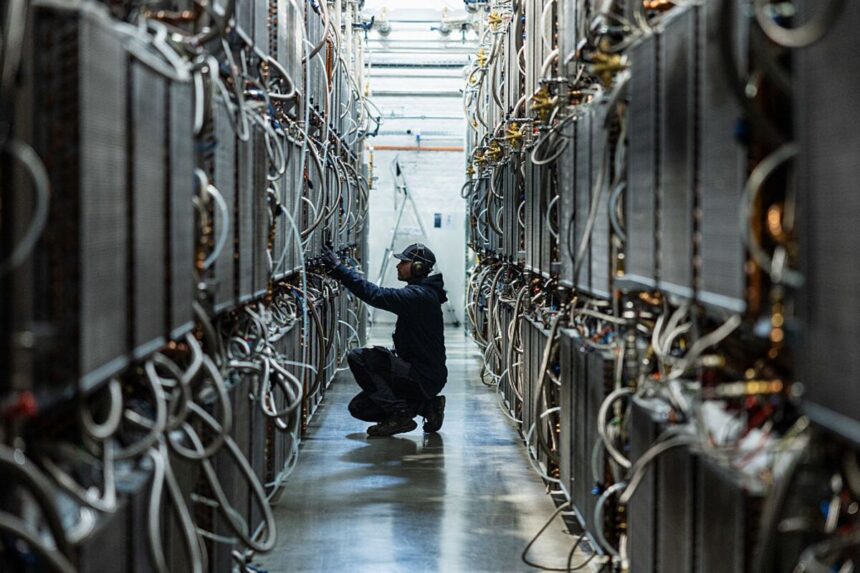Remember the hand-wringing last year about a so-called “AI winter“? Those concerns now seem almost laughable as the industry’s biggest players unleash unprecedented capital into the physical backbone of artificial intelligence.
Microsoft, Google, Meta, and Amazon collectively plan to spend upwards of $200 billion on AI infrastructure in 2025 alone—a staggering 60% increase over 2024 levels, according to analysis from Goldman Sachs. This capital wave is reshaping entire sectors of the economy, from semiconductor manufacturing to data center construction.
“We’re witnessing a fundamental recalibration of tech investment priorities,” explains Priya Misra, head of Global Rates Strategy at TD Securities. “The infrastructure buildout happening now resembles previous transformative moments like cloud computing adoption, but at a significantly accelerated pace.”
The spending surge comes as early AI investments begin delivering tangible results. Microsoft reported that its AI-enhanced products now contribute over $25 billion in annual revenue—justifying CEO Satya Nadella’s aggressive infrastructure expansion. Similarly, Google’s latest earnings call revealed its AI services have achieved 40% better efficiency metrics than just 18 months ago, creating a compelling case for additional computing capacity.
Yet this isn’t just about the tech giants throwing money around. The ripple effects are creating winners and losers throughout the supply chain.
Take Nvidia, which has seen its market capitalization surge past $3 trillion on the strength of its AI chip dominance. The company’s latest H200 GPUs are backordered through mid-2026, with prices hovering around $40,000 per unit. Competition is intensifying, however, as AMD’s recently released MI300X chips gain traction with smaller AI developers seeking alternatives to Nvidia’s ecosystem.
Data center providers are experiencing a similar boom. Equinix and Digital Realty Trust have reported occupancy rates above 95% in prime markets, with waiting lists for AI-optimized facilities stretching 12-18 months. This demand has prompted a construction frenzy, with more than 45 million square feet of data center space currently under development across North America.
“The challenge isn’t just building capacity, but building the right kind of capacity,” notes Sarah Zhang, infrastructure analyst at RBC Capital Markets. “Today’s AI workloads require 3-4 times the power density of traditional cloud computing. Many existing facilities simply can’t handle these requirements.”
Indeed, power constraints have emerged as the primary bottleneck in the AI infrastructure pipeline. In regions like Northern Virginia—home to the world’s largest concentration of data centers—local utilities are warning they may not be able to meet projected demand beyond 2026. This has sparked an urgent race to secure energy resources, with tech companies increasingly investing directly in power generation.
Amazon recently announced a $5 billion commitment to develop next-generation nuclear small modular reactors in partnership with TerraPower, while Microsoft has signed long-term agreements to finance four new solar farms totaling over 3 gigawatts of capacity.
The environmental implications of this expansion remain contentious. A typical AI training facility consumes as much electricity as 25,000 homes, raising concerns about carbon emissions. Tech companies counter that their renewable investments will ultimately make AI infrastructure carbon-neutral, though environmental groups remain skeptical.
For investors, the infrastructure boom presents both opportunities and risks. While semiconductor and data center stocks have soared, valuations have reached levels that make some analysts nervous. According to Bank of Canada data, tech infrastructure companies now trade at an average price-to-earnings ratio of 45—nearly double the broader market.
“We’re watching for signs of overcapacity,” warns Thomas Chen, portfolio manager at BMO Global Asset Management. “The history of technology is filled with examples of infrastructure overbuilding followed by painful corrections. The question isn’t whether AI will transform industries—it’s whether companies can generate enough revenue to justify these massive capital expenditures.”
Early signs suggest they can. Enterprise adoption of generative AI applications increased 380% in the past year, according to McKinsey research, with 72% of large companies reporting measurable productivity improvements from AI implementation.
For workers in the tech sector, the infrastructure push has created thousands of jobs in unexpected areas. Data center technicians, power systems engineers, and cooling specialists are suddenly in high demand, with salaries rising 15-25% year-over-year according to recruitment firm Robert Half.
“The skills gap is acute,” explains Jasmine Wu, who oversees AI infrastructure hiring at a major cloud provider. “We’re competing for talent not just with other tech companies, but with utilities, construction firms, and engineering consultancies. The person who can properly configure a liquid cooling system for an AI cluster can practically name their price.”
Even communities previously overlooked by the tech industry are benefiting. In Wyoming, a former coal mining town is being transformed into an AI compute hub, leveraging existing power infrastructure and creating hundreds of local jobs. Similar projects are underway in Quebec, where abundant hydroelectric power has attracted over $7 billion in data center investments since 2023.
As the infrastructure build-out accelerates, questions remain about who will ultimately control these critical AI resources. The concentration of computing power among a handful of tech giants has already attracted regulatory scrutiny in both North America and Europe.
“There’s a growing recognition that AI infrastructure represents a form of market power,” says Lina Khan, chair of the U.S. Federal Trade Commission. “We’re closely examining whether access to computing capacity is being used to disadvantage competitors or lock in platform dominance.”
For now, though, the focus remains on building as quickly as possible. As one infrastructure executive told me recently: “We’re laying the railroads of the AI economy. Everything else—the applications, the business models, the regulatory frameworks—will be built on top of what we’re creating today.”
The gold rush shows no signs of slowing. The only question is whether there’s enough gold for everyone who’s rushing in.






